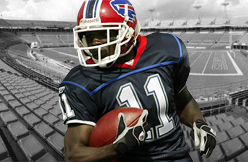The Buffalo Bills’ Roscoe Parrish is a punt returner who sometimes catches passes. That’s not where his career his heading; rather, it’s where his career is and will be, as he’s been unable to show in any of his four seasons that he can be a credibly consistent threat on offense. His catch and a half per game in 2008 seems at first glance like the sort of total that would render him obscure and/or unemployed, but the Bills should be fine with burying him on the wideouts’ depth chart as long as he continues to top the league’s punt return depth chart.
The good news is that Parrish -- who averaged 15.3 yards on his 21 returns in 2008 -- remains sublime at what is nominally his second job. That rate, best in the NFL, put him an impressive 1.2 yards ahead of the Tampa Bay Buccaneers’ Clifton Smith, the second-place finisher; the significant margin is the equivalent of Parrish being the only player onscreen during a return, something he’s good for every couple of tries.
The Miami man not only came in first in the league this past season, he’s one place behind coming in first in history. Parrish stands at second all time in the category at 14.0 YPR; he’s a mere tenth of a yard behind Jim Cason, whom you may not remember as a safety for the San Francisco 49ers and a team in Los Angeles named the “Rams” during the 1940s and '50s.
Almost as unmemorable was Parrish’s time as a wideout last season, as he gained a paltry 232 yards. That was good for a bad sixth on the team in receiving yardage, as he was sandwiched between tight ends Robert Royal and Derek Schouman. Even less impressive was the fact that Parrish’s 9.7 yards per reception tied him with rookie James Hardy for worst among wide receivers; Parrish would have actually finished third among tight ends, as both Royal and Schouman got themselves to double-digit yardage averages per reception. Parrish generally used his renowned velocity in very, very short bursts on offense.
Had the defense forced a few more three-and-outs, Parrish might have made more returns than catches in 2008; as it stands, his 24 receptions means he only finished three ahead in terms of his quantity contribution on offense. Factor in his 10 fair catches, and Parrish was actually busier on possession changes than on possessions.
That fact makes his role easy to define. He’ll only be 27 in July, but he’ll be preparing for his fifth season by the time that birthday arrives. What he, and we, should accept by then is that Parrish is a better track athlete than footballer, as he needs open space to get up to his notoriously high speed.
While elite receivers can get up to pace in a matter of a handful of strides, middling wideouts need more ground. Parrish falls into the latter category, but that’s why he’s been great at winning field-position battles. If he can make one gunner miss on a punt return, he can get enough field in front of him to get motoring. The fact that bringing back punts is a skill that’s closer to a dash than a pass route makes him better at his other task.
Parrish has emerged as a player good for a special teams touchdown per season, getting one in each of the past three campaigns, and maybe one or two more as a member of the offense, amassing five of those over his career. But that’s it. Arguing that J.P. Losman will open under center for the Bills in 2009 is only slightly more outrageous than thinking Parrish is finally going to break through on offense.
His best hope for notoriety is to overtake the top punt returner ever. As with Cason, Parrish is more likely to end up as a football trivia answer and not as an unforgettable icon. That’s fine, as long as both he and the team accept that he’s a special teams specialist who makes the occasional catch.
Think of the second-best punt returner all time in the same way as the best kicking coverage man all time: Steve Tasker, who had 51 career receptions and 10 over his first 10 seasons, provides an ideal example of how saving certain players for special teams might just be a good strategy. It’s not like Parrish is going to suddenly emerge as a player worthy of being Lee Evans’ tag team partner, so the Bills may as well happy with 20 or 30 catches from him as long as he’s only below adequate in one of his two areas.
(realfootball365.com)


